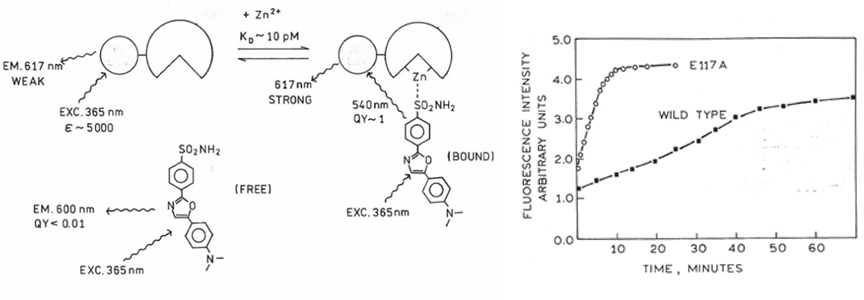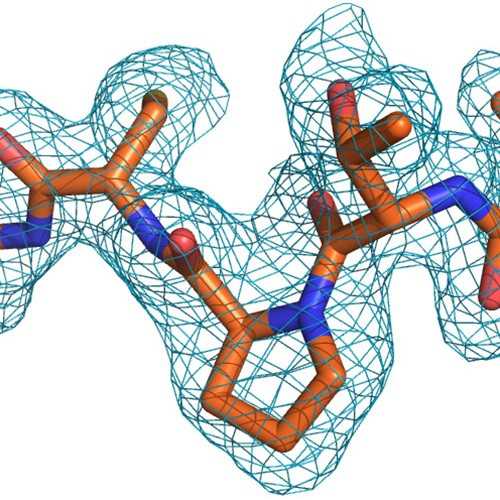E117A-apoCA-tagRFP Biosensor Protein
E117A-apoCA-tagRFP Biosensor Protein is a fluorescence-based biosensor has high sensitivity (KD = 0.04 nM) for measuring zinc, but responds much faster to changes in free zinc at low levels than the wild type carbonic anhydrase-based sensors (see figure) to changes in free zinc at low levels.
Together with 4-(dimethylaminophenyl)benzoxazolyl sulfonamide, one can measure free zinc in aqueous solution at concentrations in the picomolar range (PMID 22430627, PMID 19152866, PMID: 17163650).). It is an excitation ratiometric sensors, which makes accurate, reproducible calibration simple and minimizes most artifacts: the principle is illustrated below. When zinc is not bound, the 4-(dimethylaminophenyl)benzoxazolyl sulfonamide does not bind to the protein and emission at 610 nm (or other suitable wavelength) is weak when excited at 365 nm. However, when zinc binds to the carbonic anhydrase active site, the sulfonamide can now bind with a substantial increase in quantum yield, and efficiently transfers its energy to the attached tagRFP, which then emits in the red. Directly exciting the tagRFP at 555 nm enables one to normalize the UV-excited Zn-bound form against the total tagRFP as an excitation ratio.
A key advantage of the E117A variant is that the unsubstituted protein has an association rate constant (Kon) nearly 800-fold faster than the unsubstituted wild type apoprotein, but with only slightly weaker affinity. Thus for nanomolar free zinc concentrations, it responds to changes in free zinc ion concentration much more rapidly than the wild type apoprotein (see below).
Read plog post from Dr. Richard Thompson at Pokegama Technologies, Improving Zinc Ion Quantitation with Unique Biosensor Proteins and Buffers.
E117A-apoCA-tagRFP Biosensor Protein is a fluorescence-based biosensor has high sensitivity (KD = 0.04 nM) for measuring zinc, but responds much faster to changes in free zinc at low levels than the wild type carbonic anhydrase-based sensors (see figure) to changes in free zinc at low levels.
Together with 4-(dimethylaminophenyl)benzoxazolyl sulfonamide, one can measure free zinc in aqueous solution at concentrations in the picomolar range (PMID 22430627, PMID 19152866, PMID: 17163650).). It is an excitation ratiometric sensors, which makes accurate, reproducible calibration simple and minimizes most artifacts: the principle is illustrated below. When zinc is not bound, the 4-(dimethylaminophenyl)benzoxazolyl sulfonamide does not bind to the protein and emission at 610 nm (or other suitable wavelength) is weak when excited at 365 nm. However, when zinc binds to the carbonic anhydrase active site, the sulfonamide can now bind with a substantial increase in quantum yield, and efficiently transfers its energy to the attached tagRFP, which then emits in the red. Directly exciting the tagRFP at 555 nm enables one to normalize the UV-excited Zn-bound form against the total tagRFP as an excitation ratio.
A key advantage of the E117A variant is that the unsubstituted protein has an association rate constant (Kon) nearly 800-fold faster than the unsubstituted wild type apoprotein, but with only slightly weaker affinity. Thus for nanomolar free zinc concentrations, it responds to changes in free zinc ion concentration much more rapidly than the wild type apoprotein (see below).
Read plog post from Dr. Richard Thompson at Pokegama Technologies, Improving Zinc Ion Quantitation with Unique Biosensor Proteins and Buffers.
| Product Type: | Protein |
| Name: | E117A-apoCA-tagRFP biosensor protein |
| Extinction Coefficient: | ε555 nm = 100,001 |
| Molecular Weight: | 60,000 Da |
| Variant MPN: | T-0020 |
| Format: | Solution in pH 7.5 buffer |
| Purity: | >95% |
| Tested Applications: | Measuring free zinc ion concentrations |
| Comments: | Fluorescent-labeled zinc-free apoprotein; fluorescent protein label excitation maximum 555 nm, preferred emission wavelength ca. 610 nm |
| Storage: | +4C |
| Shipped: | Cold packs |

- T. K. Hurst, D. Wang, R.B. Thompson, C.A. Fierke, ÒCarbonic anhydrase II-based metal ion sensing: Advances and new perspectives,Ó Biochimica et Biophysica Acta (Proteins and Proteomics)1804, 393-403 (2010). PMID: 19818877; NIHMSID 157045.
- R.A. Bozym, T. Hurst, N. Westerberg, A.V. Stoddard, C.A. Fierke, C.J. Frederickson, R.B. Thompson, ÒDetermination of zinc using carbonic anhydrase-based fluorescence biosensors,Ó in Methods in Enzymology: Fluorescence Spectroscopy Vol. 450 (L. Brand and M.L. Johnson, editors) New York: Elsevier, pp 279-301 (2008). PMID 19152866.
- R. A. Bozym, A. K. Stoddard, C. A. Fierke, and R. B. Thompson, ÒMeasuring picomolar exchangeable zinc in PC-12 cells using a ratiometric fluorescence biosensor,Ó ACS Chemical Biology1(2) 103 Ð 111 (2006) PMID: 17163650
If you publish research with this product, please let us know so we can cite your paper.


